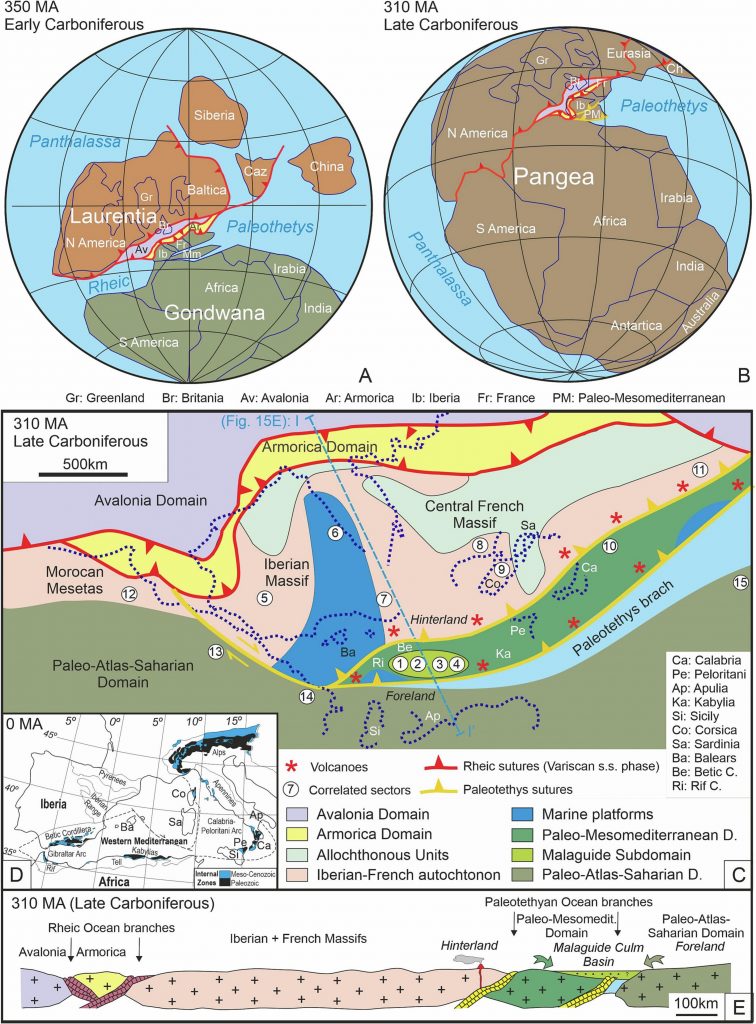Carboniferous sandstone within the Paleo-Mesomediterranean Domain (Malaguide Subdomain), in southern Spain, represents a key detrital mode within the sedimentary budget of convergent plate boundaries during the Variscan s.s. to Paleotethysian orogenic time span (≈420–300 Ma). This Carboniferous detritus corresponds with Culm lithostratigraphic depositional unit, and it covers an important gap of information (paleogeographic, paleotectonic, source areas) to the area located between the Iberian-French massifs and the African Paleo-Atlas, in the western Paleotethys. Sandstone composition is quartzolithic and records an important high-to-medium-low grade metamorphic content. The source area was a lithic and transitional recycled orogen with a signature of volcanic and ophiolitic detritus (≈330 Ma and/or older). These supplies seem to be derived from a mid-crustal deformed and thrusted pre-late Ordovician to Early Carboniferous terrane, involved in the plate convergence (the southern Europe Iberian-French massifs overriding the north African area) southeatwards of the Variscan s.s. orogenic system, rapidly exhumed and uplifted at mid-Late Carboniferoous time. Consequently, in the overriding hinterland (southern Europe: Iberian-French massifs), metamorphic basement should be already structured during middle Carboniferous when thrusting took place and deposition of Culm facies started in the Malaguide Complex, suggesting Proterozoic-Early Carboniferous (most probably, ≈420 to 330 Ma) metamorphic highlands. The presence of serpentinite-like detritus (≈330 Ma and/or older) seems to indicate a metamorphosed oceanic crust being dismantled at that time. Thus, sources from ophiolitic suture (most probably developed at ≈420–330 Ma) zones are tentatively proposed in other northern Gondwana of southwestern Europe. The occurrence of a synsedimentary volcanic activity (andesitic) should be related to a lost magmatic arc (most probably developed at ≈360–330 Ma), reinforcing the idea of a nearby subduction area. Therefore, the thick terrigenous Culm deposits (≈330–300 Ma) from the Malaguide Subdomain could be deposited in a complex foreland system basin connected northward with carbonate platforms and with a crystalline highland uplifted domain from the southern Europe Iberian-French massifs and southward with the African Paleo-Atlas Domain. The studied mid- to late Carboniferous sandstone petrofacies deeply contributes to paleogeographic reconstructions since block fragmentation and spreading, during the Paleotethysian and Alpine orogenies, rearranged the Paleozoic paleogeography now part of the Cenozoic Perimediterranean Chains. After the correlation with the Carboniferous from other western Paleotethys domains, new paleogeographic-paleotectonic constraints.

cite as: Criniti, S.; Martín-Martín, M.; Martín-Algarra, A. New Constraints for the Western Paleotethys Paleogeography-Paleotectonics Derived from Detrital Signatures: Malaguide Carboniferous Culm Cycle (Betic Cordillera, S Spain). Sediment. Geol. 2023, 458, 106534, doi: 10.1016/j.sedgeo.2023.106534.
Recent Comments